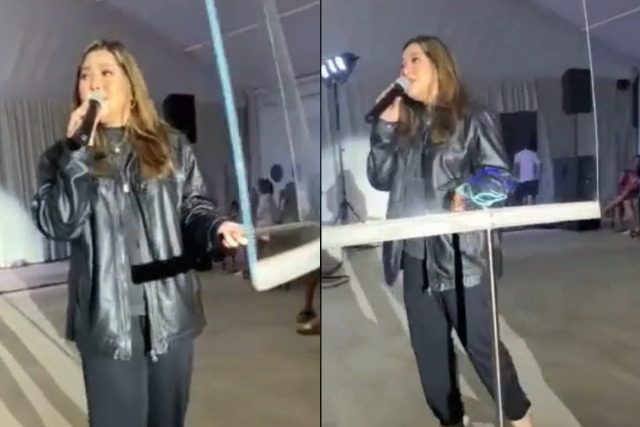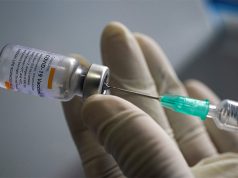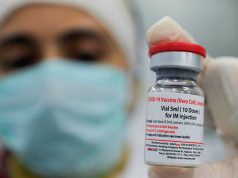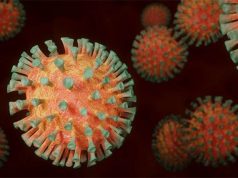
“COVID-19 is airborne.”
Filipinos emphasized that the virus causing COVID-19 can be transmitted through the air after a video of Moira Dela Torre singing with what appeared to be a movable barrier in front of her went viral.
The 27-year-old artist sang her famous hit “Tagpuan” in an indoor event where she also passed her microphone to a guest whose face mask was sitting on the chin.
The clip, which was originally uploaded on TikTok and reshared on Twitter, alarmed some Filipinos in the online community due to the supposed missteps spotted in relation to health and safety protocols.
Dela Torre, who was maskless, was singing while holding what appeared to be a huge barrier which some Twitter users thought was a substitute to the face shield required to be worn in public places.
She also passed along her microphone to a guest who was not wearing a face mask properly.
Forget faceshield, windshield is the new trend. pic.twitter.com/1UBrSYHezA
— 🟢 Tasty (@tasty_vive) May 11, 2021
“Matagal nang kalokohan ‘yung mga shows na naka-face shield yung artista pero walang face mask… Then this abomination… Plexiglass barriers might shield droplets, but they impede airflow and thus may even increase COVID risk because #COVIDisAirborne,” a Twitter user said in response to the clip.
“Seriously? Covid is AIRBORNE. Your shield won’t help (facepalm emoji). Who’s more to blame? The organizer or the person who thought the shield would work or Moira?” another online user wrote.
“COVID is airborne so what good do shields do? Lady Gaga even performed a song and dance number for VMAs WITH a mask on so why can’t local artists do it?” a different Filipino wondered.
Last year, the American singer-songwriter performed at the MTV Video Music Awards wearing fashionable face masks in light of the COVID-19 pandemic.
Lady Gaga then urged the public to wear a mask because “it’s a sign of respect.”
Another Twitter user quipped that Dela Torre could be holding a “teleprompter” that can project words to a speaker as a cue.
“Gara naman ng teleprompter ni Moira. Anlaki at movable pa HAHAHAHA,” the Filipino wrote.
Some notes on COVID-19 transmission
The United States’ Centers for Disease Control and Prevention (CDC) recently updated its COVID-19 guidelines by acknowledging that the virus can be transmitted through very fine respiratory droplets and aerosolized particles.
It also said that infection can occur even if people are standing more than six feet apart, given that they are in enclosed spaces with poor ventilation.
Increased exhalation of respiratory fluids through physical exertion like singing, exercising and shouting will also increase the risk, as well as the duration of exposure.
The World Health Organization also updated its Q&A page dedicated to COVID-19 by saying that people “can be infected when aerosols or droplets containing the virus are inhaled or come directly into contact with the eyes, nose, or mouth.”
“The virus can also spread in poorly ventilated and/or crowded indoor settings, where people tend to spend longer periods of time. This is because aerosols remain suspended in the air or travel farther than 1 meter (long-range),” it added.
Last year, a Forbes article noted that face shields and Plexiglass barriers “are not a safe alternative to covering your nose and mouth.”
It also said that “microscopic droplets create a fine mist that’s invisible to the naked eye — an airborne solution, or aerosol.”
The article cited a document reportedly created by a group of scientists as organized by aerosol researcher Jose-Luis Jimenez of the University of Colorado, Boulder.
“Face shields do not offer much protection against aerosols (also see this video), while masks do,” part of its note said, linking a 2014 study.
It added that Plexiglass barriers offer “limited” protection since it is only useful in avoiding direct droplet infection and direct aerosol transmission “whenever people are in close proximity and distance cannot be kept.”
“However, as aerosols follow the air movements indoors, the protective effects of the [plexiglass] barriers against aerosols will be limited. [Plexiglass] barriers alone are not a sufficient approach to protect against aerosol transmission. Their installation alone cannot protect against indoor aerosol transmission and should not be regarded as safe and sufficient protection,” the document said.









